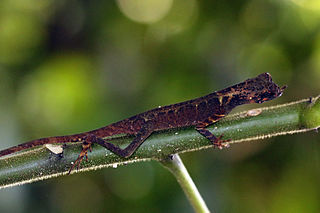Arthrosaura is a genus of spectacled lizards in the family Gymnophthalmidae.

Anomochilidae is a family of snakes with one genus, Anomochilus, containing three species of snake. Members of the genus are known as anomochilids, or by the common names dwarf pipesnake, lesser pipesnake, and giant blind snake. Initially created as Anomalochilus in 1890 for the species A. weberi, the genus was renamed in 1901 because the original name was already in use for a genus of beetles. Dwarf pipesnakes are small and cylindrical, with short, conical tails and small, rounded heads that are continuous with the neck. They have blackish to purplish-brown uppersides and dark brown or black undersides, with orange-red bands around the tail and a variety of pale markings on the snout and belly. All three species of dwarf pipesnake are endemic to Sundaland, where they are found on the Malay Peninsula and the islands of Sumatra and Borneo.

Chironius scurrulus, commonly known as the smooth machete savane, is a large slender colubrid snake. It is also known as Wagler's sipo.

Trimeresurus hageni, commonly known as Hagen's pit viper and Hagen's green pit viper, is a species of venomous snake in the subfamily Crotalinae of the family Viperidae. The species is native to Southeast Asia. There are no subspecies that are recognized as being valid.
Vanzolini's worm lizard is a species of amphisbaenian in the family Amphisbaenidae. The species is native to northern South America.

Liotyphlops ternetzii, also known commonly as Ternetz's blind snake, is a species of snake in the family Anomalepididae. The species is endemic to South America.
Theodorus Willem van Lidth de Jeude was a Dutch zoologist and herpetologist. He is not to be confused with his grandfather's brother, the Dutch veterinarian and zoologist Theodoor Gerard van Lidth de Jeude (1788–1863).

Aphaniotis ornata is a species of lizard in the family Agamidae. The species is endemic to Borneo.
The Dutch leaf-toed gecko is a species of lizard in the family Phyllodactylidae. The species is endemic to the Caribbean.
Amphisbaena myersi is a species of worm lizard in the family Amphisbaenidae. The species is endemic to Suriname.

Kentropyx striata, known commonly as the striped whiptail, is a species of lizard in the family Teiidae. The species is endemic to northern South America.
Arthrosaura tyleri is a species of lizard in the family Gymnophthalmidae. The species is endemic to Venezuela.
Arthrosaura versteegii is a species of lizard in the family Gymnophthalmidae. The species is indigenous to northeastern South America.
Neusticurus tatei, also known commonly as Tate's neusticurus, is a species of lizard in the family Gymnophthalmidae. The species is endemic to Venezuela.
Yanomamia hoogmoedi is a species of lizard in the family Gymnophthalmidae. The species is endemic to Guyana.
Sphenomorphus buettikoferi is a species of skink, a lizard in the family Scincidae. The species is endemic to the island of Borneo.

Micrurus averyi, also known commonly as Avery's coral snake and the black-headed coral snake, is a species of coral snake, a venomous snake in the genus Micrurus of the family Elapidae. The species is indigenous to northern South America.
Tytthoscincus hallieri is a species of skink, a lizard in the family Scincidae. The species is native to Southeast Asia.

The dull bamboo snake, also known commonly as the Javanese false cobra, is a species of snake in the subfamily Pseudoxenodontidae of the family Colubridae. The species is endemic to Indonesia. There are three recognized subspecies.
Dopasia buettikoferi, also known commonly as the Bornean glass snake and Buettikofer's glass lizard, is a species of lizard in the family Anguidae. The species is native to Indonesia and Malaysia on the island of Borneo.








